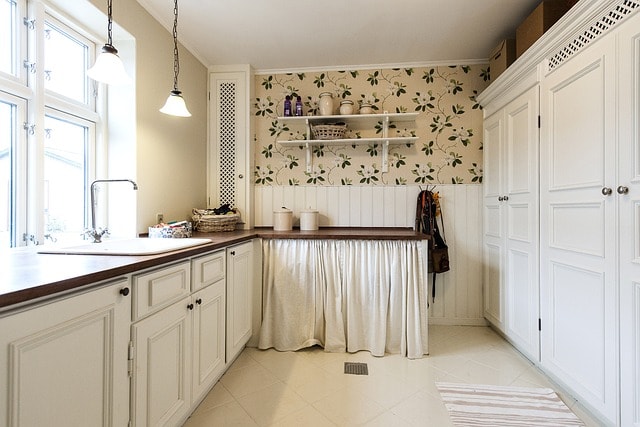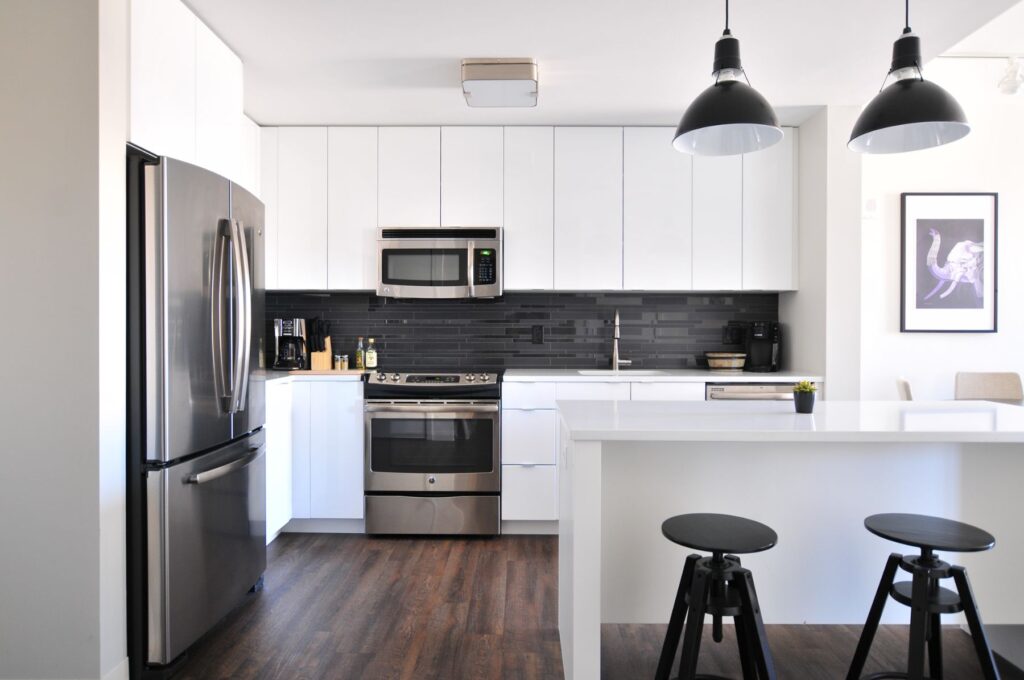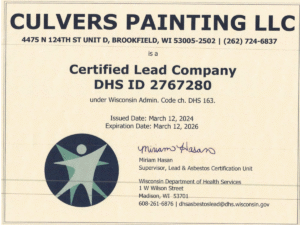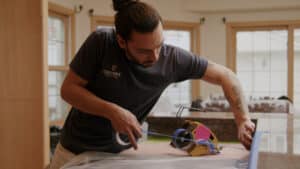Key Points
- Painting your kitchen cabinets is a budget-friendly alternative to buying new custom cabinets, allowing you to completely change the look and feel of your kitchen while saving you time and effort.
- While you can do it on your own, we highly recommend hiring professionals who have the experience, tools, and techniques to avoid common DIY mistakes. Things like uneven coats and drips reduce the quality of the finish and will probably need extra attention further down the line. In addition, professionally sprayed kitchen cabinets will be farm more resilient against bumps and scratches in the long-run.
Why Paint Your Kitchen Cabinets?
Maybe you want to completely facelift your kitchen (without breaking the bank in the process), or you want to have creative oversight of your interior design.
Maybe you simply feel your place needs a do-over.
If this sounds like you, kitchen cabinet painting could be a cost-effective and transformative approach to enhancing your kitchen and “wowing” your guests.
Brand new custom kitchen cabinets can cost tens of thousands of dollars (really!), whereas hiring professional painters to re-paint your kitchen cabinets can cost as little as a few thousand.
While at first glance this makes kitchen cabinet painting an appealing option both aesthetically and financially, there are other things to consider before making a decision.
Let’s jump in.

It looks better.
Painting kitchen cabinets is an easy way change how your kitchen looks. Even just the cabinet doors can completely change how everything comes together. The great thing is that the possibilities are quite open with regards to how things will look in the end.
When painting cabinets, the sky is the limit. From matte paint to high-shine, and subtle classic colors to modern flair, the options are wide open when you restore your kitchen with new paint.
It’s cost-effective.
The question “should i paint my kitchen cabinets” often comes out of a desire to change how things look without completely blowing up your kitchen in a remodel.
The problem, as we’ve written about before, is that new custom cabinets are pretty expensive. By now, you probably know that new, custom cabinets generally start at $20,000, even for a small kitchen.
A new homeowner might not really be able to afford it. Painting your kitchen cabinets is a simple alternative that saves you the money and the trouble. Using latex paint or oil paint is a cost-effective option for painting kitchen cabinets, providing a durable and attractive finish.
Your Goals and Budget
A key thing to consider, then, is just how much money you’re willing to spend. Your budget should include materials, labor costs, and/or (if you’re thinking of doing it yourself) your time.
If your budget allows you to replace fixtures in addition to paint, this small hack can be another fast way to modernizing your kitchen.
A Word of advice: think of how you want things to look and feel after all is said and done and work backwards.
If you’re unsatisfied with the layout of your kitchen and your budget allows it, then by all means pursue new cabinetry! While custom cabinets will give you exactly what you’re looking for, Ready-to-Assemble (RTA) cabinets are another way to overhaul your kitchen while spending 50-75% of what a custom kitchen might cost. RTA cabinets, or Ready-To-Assemble cabinets, are modular kitchen, bathroom, or storage cabinets that are shipped in flat-pack boxes and require assembly by the buyer. They’re popular because they tend to be more affordable than pre-assembled cabinets, as they save on shipping costs and labor. And these days, RTA cabinets offer a range of designs and materials, allowing for customization and flexibility in home design projects.

DIY or Hire a Professional for Kitchen Cabinet Painting?
We advise against doing it yourself when it comes to kitchen cabinet painting in a home you plan to stay in long-term.
Here’s why.
The main selling point of painting your wood cabinets yourself is saving money. Sure, you’ll save on labor costs – but we think the cons far outweigh the pros. A DIY kitchen cabinet paint project is time-consuming, you’ll get a lower-quality finish, and there are countless risks of mistakes that you’ll be looking at for years to come. Professional painters have the tools to get your your painted cabinets done in no time, with a picture-perfect finish and durable surface.
We could sit here and talk (or write) for hours about this – we’ve got years of experience telling us to warn you about this.
Let’s cut to the chase and illustrate the difference by briefly going through what our process looks like:
Step-by-Step Professional Kitchen Cabinet Painting Process
#1 – Disassemble the Cabinets
We start by carefully removing the cabinet doors, drawers, and all the cabinet hardware such as hinges and knobs.
Before anything else happens, we label each piece of the cabinet with masking tape and a marker to ensure we can reassemble them precisely as they came apart. This is critical to painting kitchen cabinets well because older cabinets can change with time and need to be put back in the same place – including hardware.
Then, while the cabinet boxes get painted in your home, all of your doors and drawer fronts go to our professional spray facilities.
#2 – Clean Thoroughly
Using a degreaser or a mix of water and mild detergent, we scrub all cabinet surfaces, removing grease, dirt, and grime. Fixtures that have been close to stoves or cooking areas for too long may need extra effort.
We follow up with a vacuum or a tack cloth to eliminate dust and finalize surface prep. Thoroughness here is a must, as a clean surface is essential for the primer and paint to adhere properly.
#3 – Sanding and priming
Oak cabinets, cherry cabinets, whatever – they’re all in the end just solid wood cabinets. They need to be sanded against the wood grain before anything else can happen.
We use a light- to medium-grit sandpaper to sand all cabinet surfaces, including doors and frames. Sanding removes the glossy finish and creates a rough texture that helps the primer adhere well.
We then spray on a high-quality oil-based primer. If you’re a DIY-er, this can be done with a brush or roller. If a cabinet door has many crevices or imprints, a small brush is preferable for touch-up. Priming seals old finishes, blocks stains, and provides a solid base or “tooth” for the paint we’re about to apply.
#4 – Coat and sand again
Here we’ll use a professional-grade sprayer or a high-density foam roller to apply the first coat of paint to the wood cabinets. Sprayers – which our professionals are trained to use – offer a smooth finish similar to out-of-factory fixtures.
We apply thin coats to avoid drips and ensure thorough coverage.
Once the first coat is dry, we lightly sand the surfaces with fine-grit sandpaper. This step smooths out any imperfections and prepares the surface for the final coat.
#5 – Paint again and reassemble
This final coat will provide durability and a finished appearance to the cabinets. We apply using the same method used before and then allow it to cure fully according to the paint manufacturer’s instructions.
With your freshly painted cabinets complete, we bring the cabinet doors and hardware back to your home and carefully reassemble everything. Here, the labels we told you about will come in handy – you should not be left with extra screws after getting everything back together!
Common Mistakes When DIYing
Now that you know what you’re getting into, here are some things that people often forget about or simply do wrong when painting their own kitchen cabinets.
Underestimating the amount of time it will take
Many people get into these kinds of projects not knowing how time-consuming they are. Painting kitchen cabinets is not a job for everyone. It takes days even for professionals with lots of experience.
Being in a hurry can lead to cutting corners and skipping steps. Often, this just means they have to hire professional painters to fix their mess in the near future.
Not removing the cabinet doors and hardware
A simple, but time-consuming, step that will save you time and headaches in the future. If you’re spraying your paint on, it might clog up hinges. If you’re brushing it on, get ready to use tiny brushes in awkward positions to reach all the nooks and crannies.
It’s just not ideal to leave hardware on your old cabinets and paint them in place.
But people fear disassembling kitchen cabinets because they don’t really know how to put them back together. In contrast, our team has been there and done that a thousand times over.
Skipping proper prep work and cleaning
Like with other renovation projects, prep work is often the most important part of the ordeal. Professional painters know where to place things, how to lay things out, and how to prepare equipment to save time and money.
Prepping with proper taping, sanding, and priming will save you time and effort, and provide a much more durable finish.
So, Should I Paint My Kitchen Cabinets?
If you’re looking for a way to revitalize your kitchen without spending money on customized carpentry from a cabinet maker, painting your kitchen cabinets can be a beautiful and cost-effective solution.
Still, know what you’re getting into before you paint cabinets. Expect professional painters to charge $5,000+ for quality painting work, while a DIY project might be a few hundred dollars and a few weekends of work.
If you think you’re up for it, you can follow our process when painting your cabinets (even if you’re not a professional painter), and learn the hands-on way! Or, if you’re ready for a free kitchen cabinet painting quote in the Milwaukee-Madison region, we can help. Call today to learn more and schedule a consultation today.





